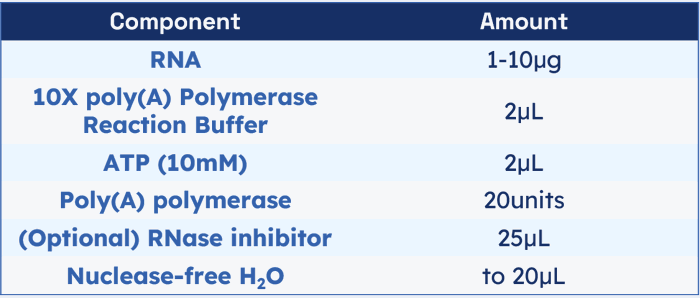Product description: Poly(A) Polymerase uses ATP as a substrate for template-independent addition of adenosine monophosphate to the 3'-hydroxyl termini of RNA molecules.
Source: Recombinant E.coli
Concentration and Size: 5U/μL
Unit Definition: One unit is defined as the amount of enzyme that will incorporate 1nmol of AMP into RNA in a 20μL volume in 10 minutes at 37°C.
Storage Buffer: 20mM Tris-HCl (pH7.5@25℃), 1mM EDTA, 300mM NaCl, 1mM DTT, 0.1%(v/v) Triton X-100,50%(v/v) glycerol.
Companion Product: 10X poly(A) Polymerase Reaction Buffer, Cat#ON-127, 500mM Tris-HCl, (pH7.9@25℃), 2.5M NaCl, 100mM MgCl2.
Protocol: The standard reaction will produce ~150bp long poly(A)-tail on up to 10ug of capped or uncapped RNA from IVT reactions and co-transcriptional capping reactions need to be purified before adding to the poly(A)-tailing reaction.
1. Combine the following reagents:
2. Incubate reaction at 37°C for 60 minutes.
3. Stop reaction by adding EDTA to final concentration of >11mM.
* Before poly(A)-tail reaction, heat-denaturation of the RNA may improve the efficiency of adding poly(A)-tail.
Storage Conditions: -20℃
Quality Assurance: Free of endonuclease, exonuclease and RNase activities.
Physical Purity: >95% by SDS-PAGE.
